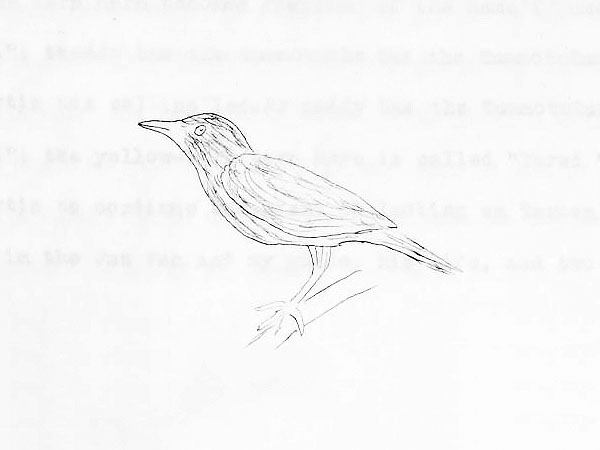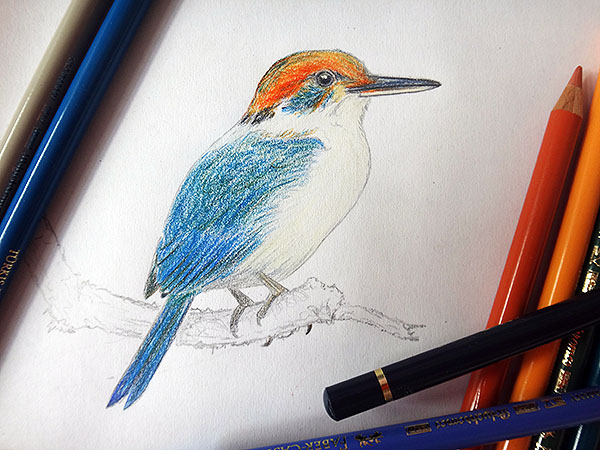When you’re dealing with extirpated/extinct birds, you will sooner or later come across species that raise more questions than others.
Such a species is the Mangareva-yes-what-actually?:
“Lanius gambieranus Lesson, 1844, Écho du Monde Savant, p. 232 (cf. Ménegaux, p. 180). IlesGambier. Type perdu depuis longtemps.
Connue seulement par la description du spécimen qui était autrefois dans la collection du Docteur Abeillé de Bordeaux. Lesson précise qu’une peinture fut préparée par M. Charles Thélot de Rochefort, mais nous n’avons pas retrouvé cette peinture, ni d’ailleurs le spécimen.
[RÉPARTITION ET STATUT]. – Selon Lesson, le spécimen décrit provenait des îles Gambier. Ces îles furent visitées par plusieurs expéditions maritimes françaises avant 1840, et le spécimen fut probablement rapporté par le frère de Lesson, le Docteur Adolphe Lesson, qui voyagea durant quatre années dans les mers du Sud comme «Chirurgien» à bord d’un bateau. Le spécimen était autrefois dans la collection Lesson à Rochefort.
Les seules autres mentions de passereaux aux îles Gambier sont données par Garrett qui trouva des fauvettes durant la seconde moitié du xix* siècle (Wiglesworth, 1891b) et par Buck (1938) qui note KOMAKO – «Reed Warbler». Signalons aussi qu’une fauvette fut observée sur l’îlot Tepapuri en 1971 (Thibault, 1973b). Ce dernier oiseau, blanchâtre dessus et brun dessous, devait être un erratique de la forme habitant les atolls au nord des Gambier, A. caffer ravus. Deux spécimens M.N.H.N ont été considerés comme des oiseaux pouvant provenir des îles Gambier (Lacan et Mougin, 1974b), mais il s’agit vraisemblabIement d’une forme éteinte d’ A. luscinia provenant de Micronésie (Holyoak et Thibault, 1978b). L’expédition Whitney ne trouva pas de fauvette en visitant les îles Gambier, en dépit de nombreuses recherches en 1922 (Beck et Quayle, ms).
[DISCUSSION], – L’oiseau décrit par Lesson ne correspond à aucune forme de spécimens connus. Il est douteux qu’il s’agisse d’une pie-grièche (Laniidae), comme l’avait pensé Lesson. Il est également peu probable que se soit un siffleur (Pachycephala), comme certains auteurs l’ont suggéré (Lacan et Mougin, 1974b; Thibault, 1973b).
La taille, la forme et la coloration font plutôt penser à une fauvette, voisine des formes habitant les îles Cook. Cette hypothèse serait d’autant plus vraisemblable qu’il serait étonnant que des îles volcaniques de la taille des Gambier n’aient pas eu de fauvettes. Sans doute, Lesson avait déjà décrit en 1820 la Fauvette de Tahiti comme appartenant au genre Tatare, mais il n’est pas étonnant qu’il n’ait pas établi de relation entre cette fauvette et l’oiseau des Gambier, en raison de leurs différences morphologiques importantes.
De nombreuses interrogations subsistent au sujet de cet oiseau et il n’est pas évident qu’il ait été véritablement collecté aux Gambier, bien que les autres descriptions de Lesson ne présentent pas d erreurs de localité. “
translation:
“Lanius gambieranus Lesson, 1844, Écho du Monde Savant, p. 232 (cf. Ménegaux, p. 180). Gambier Islands. Type long lost.
Known only by the description of the specimen that was once in the collection of Doctor Abeillé de Bordeaux. Lesson specifies that a painting was prepared by Mr. Charles Thélot de Rochefort, but we have not found this painting, nor indeed the specimen.
[DIVISION AND STATUS]. – According to Lesson, the described specimen came from the Gambier Islands. These islands were visited by several French maritime expeditions before 1840, and the specimen was probably brought back by Lesson’s brother, Doctor Adolphe Lesson, who traveled for four years in the South Seas as a “surgeon” aboard a boat. The specimen was formerly in the Lesson collection in Rochefort.
The only other records of passerines in the Gambier Islands are given by Garrett who found warblers in the second half of the nineteenth century (Wiglesworth, 1891b) and by Buck (1938) who noted KOMAKO – “Reed Warbler”. It should also be noted that a warbler was observed on Tepapuri islet in 1971 (Thibault, 1973b). This last bird, whitish above and brown below [shouldn’t it be vice versa?], must have been an erratic of the form inhabiting the atolls north of the Gambiers, A. caffer ravus. Two M.N.H.N specimens have been considered as birds that may have originated from the Gambier Islands (Lacan and Mougin, 1974b), but they are probably an extinct form of A. luscinia from Micronesia (Holyoak and Thibault, 1978b). [they are now known to indeed be specimens of a species formerly inhabiting the island of Mangareva] The Whitney expedition did not find a warbler when visiting the Gambier Islands, despite extensive research in 1922 (Beck and Quayle, ms).
[DISCUSSION], – The bird described by Lesson does not correspond to any form of known specimens. It is doubtful that it is a shrike (Laniidae), as Lesson had thought. It is also unlikely to be a whistler (Pachycephala), as some authors have suggested (Lacan and Mougin, 1974b; Thibault, 1973b).
The size, shape and coloring are more like a warbler, similar to the forms found in the Cook Islands. This assumption would be all the more likely since it would be astonishing if volcanic islands the size of Gambier did not have warblers. No doubt Lesson had already described the Tahitian Warbler in 1820 as belonging to the genus Tatare, but it is not surprising that he did not establish a relationship between this warbler and the Gambier bird, because of their significant morphological differences.
Many questions remain about this bird and it is not obvious that it was really collected in Gambier, although the other descriptions of Lesson do not present errors of locality.” [3]
Today, most ornithologists think that the description fits best with the extinct Mangarevan Reed-Warbler, a bird that is known to have indeed existed. Yet, there are in fact two surviving specimens of this species, Acrocephalus astrolabii Holyoak & Thibault, which, however, are still often referred to as having been collected somewhere in Micronesia, an assumption that is now obsoleted. [4]
However, the reed-warbler was much larger than 14 cm, and it lacks the yellow underside that our enigmatic bird is said to have had; but let’s just take a look on the original description, it is in French and reads as follows:
„Cette pie-grièche est fort voisine du Lanius tabuensis de Latham. Comme elle, on la trouve dans le mer du Sud, et c’est aux îles Gambier qu’elle vit.
Cette espèce a les formes courtes et trapues. Elle mesure 14 centimètres. Ses ailes sont presque aussi longues que laqueue; son bec est peu crochu, bien que denté; il est noiràtre ainsi que les tarses; tout le plumage en dessus, les ailes et la queue sont d’un brun olivàtre uniforme; le devant du cou, à partir du menton jusqu’au haut de la poitrine, est olivàtre foncé; tout le dessous du corps, depuis le haut du thorax jusqu’aux couvertures inférieures, est du jaune le plus vif et le plus égal; les plumes tibiales sont brunes, mais cerclées d’une sorte de jarretiere jaune à d’articulation le dedans des ailes est varié de jaune et de blanc, ce qui forme un rebord étroit, blanc dessous du fouet de l’aile; la queue est légèrement échancrée, et le sommet des rectrices présente un point jaune.” [1]
Here is my translation:
“This shrike is very close to Lanius tabuensis [Aplonis tabuensis (Gmelin)] of Latham. Like this, it is found in the South Sea, and it lives in the Gambier Islands.
This species has a short, squat form. It measures 14 centimeters. Its wings are almost as long as the tail; the beak is slightly hooked, but dentate; it is black as well as the tarsi; all the plumage above, the wings and the tail are uniformly olive brown; the front of the neck, from the chin to the top of the breast, is dark olive; the whole lower part of the body, from the top of the thorax to the lower coverts, is the liveliest and most even yellow; the tibial feathers are brown, but circled in a sort of yellow, hinged garter, the underside of the wings is varied with yellow and white, forming a narrow, white rim beneath the whip of the wing; the tail is slightly forked, and the top of the rectrices are dotted yellow.”
You see, the species was described as a shrike (Laniidae) and as being very closely related to Lanius tabuensis.
Well, shrikes, of course, do not exist in Oceania at all, and Lanius tabuensis is called Aplonis tabuensis today and is a starling (Sturnidae), the South Sea Starling. You must know that in the 19th century still no one really had any idea of biogeography, and the same applies to the relationships between the different bird species.
Not a shrike, but what about a starling – Aplonis gambieranus?
Hm, according to the description rather not, the size (14 cm) seems a bit too small (my gut feeling), and the colors do not fit to any other Polynesian starling.
Not a starling, but what about a robin – Eopsaltria gambierana?
“EOPSALTRIA GAMBIERANA.
Lanius gambieranus, Less. Echo de M. S. 1844, p. 232.
Eopsaltria gambierana, Hartl. Wiegm. Arch. für Naturg. 1852, p. 133.
Low or Paumotu Islands (Gambier’s Islands or Mangarewa).” [2]
This genus does not occur in Polynesia, but the closely related genus Petroica does indeed (both genera belong to the family Petroicidae), however, both genera, in my eyes, can be excluded for biogeographic reasons.
Not a robin, but what about a whistler – Pachycephala gambierana?
The bird was for some time also thought to may have been a whistler and the genus Pachycephala indeed is occuring in Polynesia, yet only in the western part, namely in Fiji, Samoa and Tonga but not further east, so, no.
Not a whistler, but what about a monarch – Monarcha gambierana?
Personally, I think that the mysterious bird from the island of Mangareva most likely was a monarch species (Monarchidae), namely one of the genus Monarcha (formerly Pomarea). The size indication fits very well, as well as the specified colors, these fit quite well with the young birds of the surviving species of this genus. Apart from that, this genus also fits very well for biogeographical reasons, the distance between the Society Islands and the Gambier Archipelago is only slightly larger than that between the Society Islands and the Marquesas (where the genus still occurs today).
***
Lastly, I would like to mention that this species is officially no longer regarded as having existed at all, not just as dead/extinct, but as ‘having never existed’!
But why?
Because the type does not exist anymore? – this applies also to other species!
Because there was a picture that is now lost as well? – who actually is screwing up something like that, and … this too applies also to other species!
Because no one can say what kind of bird it actually could have been?
In my humble opinion this enigmatic bird, which might very well have existed, most likely was either an somewhat aberrant starling or a member of the monarch family.
*********************
References:
[1] R.-P. Lesson: Catalogue descriptif des oiseaux nouveaux, rares ou peu connus, de la collection Abeillé. L’Écho du monde savant et l’Hermès: journal analytique des nouvelles et des cours scientifiques. 1844 pt. 2: 232
[2] George Robert Gray: Catalogue of the birds of the tropical islands of the Pacific Ocean in the collection of the British Museum. London: printed by order of the Trustees 1859
[3] D. T. Holyoak; J.-C. Thibault: Contribution à l’étude des oiseaux de Polynésie orientale. Mémoires du Muséum national d’histoire naturelle 127(1): 1-209. 1984
[4] Alice Cibois; Jon S. Beadell; Gary R. Graves; Eric Pasquet; Beth Slikas; Sarah A. Sonsthagen; Jean-Claude Thibault; Robert C. Fleischer: Charting the course of reed-warblers across the Pacific islands. Journal of Biogeography 38(10): 1963-1975. 2011
*********************
edited: 29.07.2020


